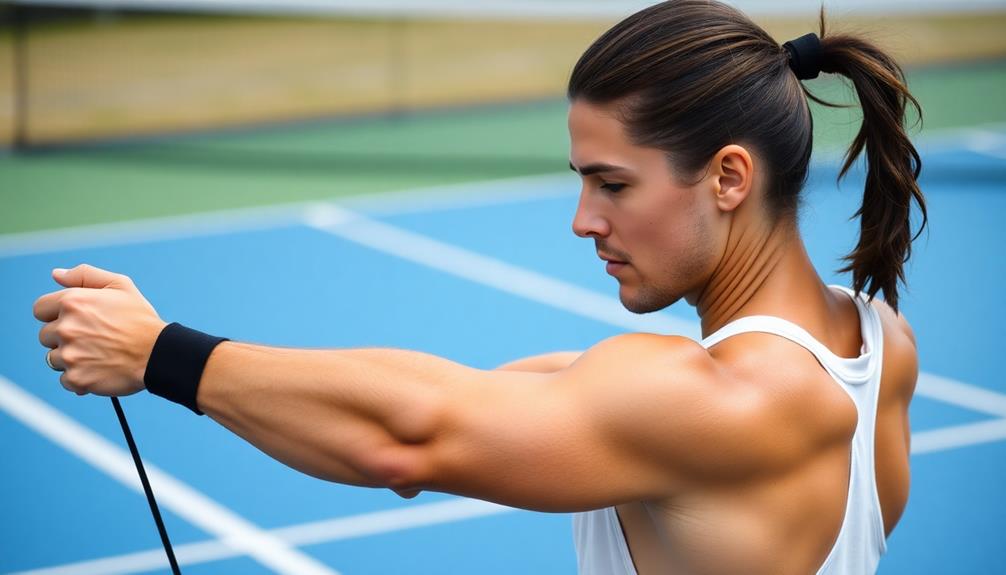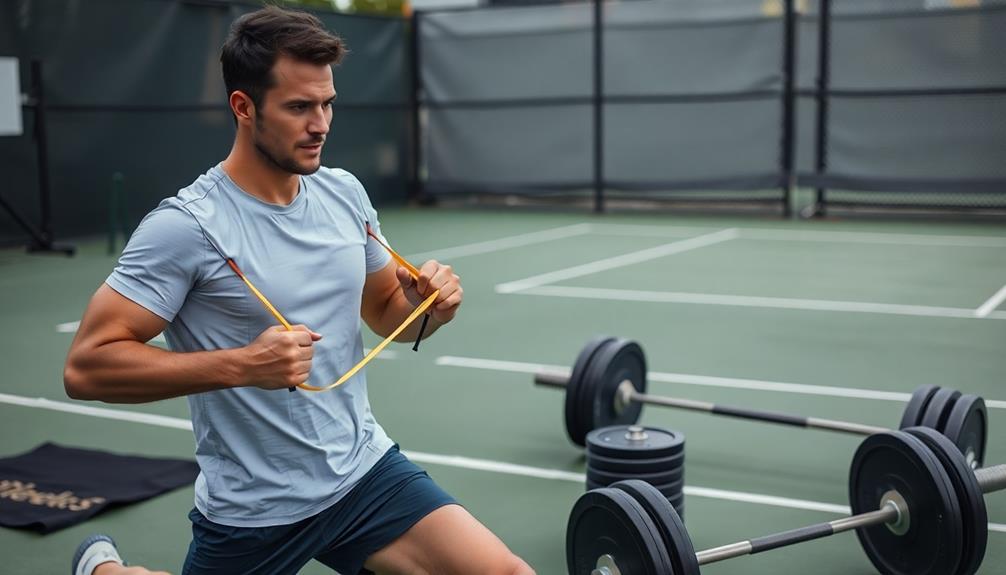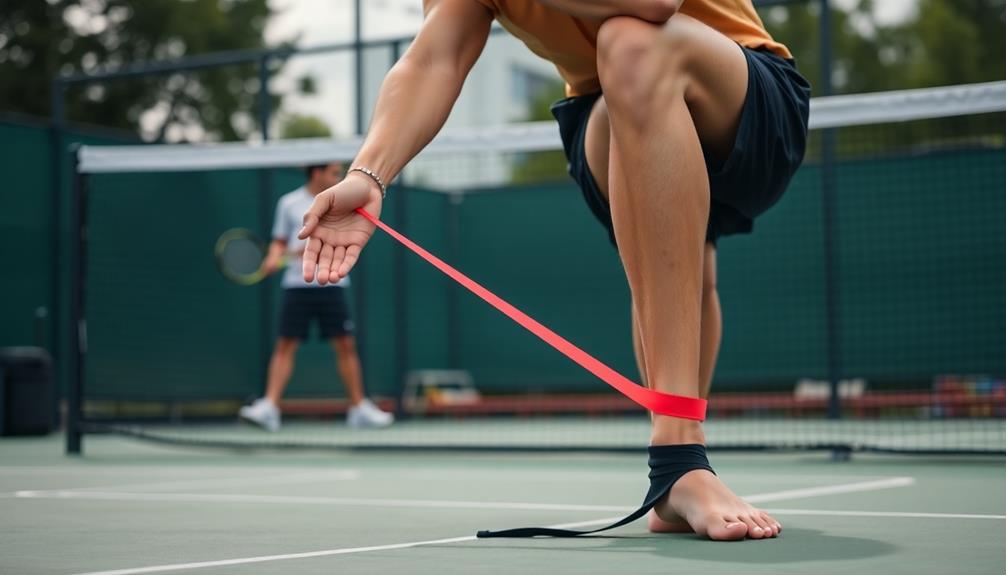To maximize your tennis resistance training, focus on five key areas. First, incorporate compound movements like squats and deadlifts to work multiple muscles simultaneously. Second, add tennis-specific exercises that mimic on-court movements, such as rotational exercises and lateral lunges. Third, implement progressive overload by gradually increasing workout intensity over time. Fourth, balance strength training with flexibility work through regular stretching and activities like yoga. Finally, prioritize recovery and rest to allow your muscles to heal and grow. By following these tips, you'll enhance your on-court performance and reduce injury risks. Dive deeper to reveal the full potential of your training regimen.
Core Insight
- Focus on compound exercises like squats, lunges, and deadlifts to work multiple muscle groups simultaneously.
- Incorporate tennis-specific movements like rotational exercises and lateral lunges to improve on-court performance.
- Implement progressive overload by gradually increasing weight, reps, or sets to continually challenge yourself.
- Balance strength training with flexibility exercises to enhance movement fluidity and reduce injury risks.
- Prioritize proper rest and recovery, including adequate sleep and nutrition, to support muscle growth and overall performance.
Focus on Compound Movements

Compound exercises are the key to effective strength training for tennis players. These exercises work multiple muscles at the same time, similar to the complex movements in tennis. Focus on squats, lunges, deadlifts, and push-ups to build overall strength and balance. Resistance bands can be added to these exercises to mix things up and challenge you, especially when traveling or working out at home.
When starting with compound exercises, begin with just your bodyweight to get the form right. As you get better, slowly add weights to make it harder. Aim for 2-3 sets of 8-12 reps for each exercise, changing the weight to keep proper form throughout.
Include both upper and lower body compound exercises in your training. This balanced approach will improve your power, agility, and endurance on the tennis court. Always warm up before your workouts and cool down after to prevent injury and help recovery.
Incorporate Tennis-Specific Exercises

To improve your tennis game, add exercises that copy your on-court moves. Try rotational exercises like cable rotations, medicine ball throws, and resistance band twists. These will help with your serve and groundstrokes. Choose strong latex resistance bands that match your strength level. Work on footwork and speed with lateral lunges, jump squats, and plyometric drills.
Don't forget your core and stabilizer muscles. They keep you balanced when you change direction quickly. Planks, Russian twists, and stability ball exercises are good choices. Train your shoulder muscles to avoid injuries and boost your serve. Use resistance bands or light dumbbells for external rotations and shoulder presses.
Progressive Overload Is Key

To get better at tennis, you need to keep pushing yourself. This means slowly making your workouts harder over time. As your body gets used to what you're doing, you'll need to do a bit more to keep seeing progress. Compression sleeves can help you recover and do well during tough training, so you can stick with your plan to keep pushing yourself.
First, figure out how strong and fit you are now. Then, bit by bit, add more weight, reps, or sets to your exercises. For instance, if you're using resistance bands for forehand drills, start with lighter bands and fewer reps. As you get stronger, switch to heavier bands or do more reps.
Balance Strength and Flexibility

Strength and flexibility are both key for tennis players. You need to work on both to play your best on the court. Stretch your shoulders, back, and legs often. Protein can help your muscles recover and grow. Eat well and exercise to stay in top shape.
Stretch before and after you play. Try yoga or Pilates for flexibility and a strong core. Being flexible helps you move smoothly and avoid injuries. Strength gives you power on your shots.
As you keep working out, pay attention to your flexibility. If you feel tight or can't move as well as before, change your routine to fix those problems.
Prioritize Recovery and Rest

After tough workouts, focus on rest and recovery. Your body needs time to heal and get stronger, so don't forget how important breaks are. Aim to sleep 7-9 hours each night to help your muscles recover and stay healthy. Think about using cold towels to help cool your body down and recover better when you're resting.
Add easy recovery exercises to your routine. This can mean stretching, yoga, or a relaxed swim. These get your blood moving and ease sore muscles without putting too much stress on your body.
Eat right to fuel your body. Have a mix of protein, good carbs, and healthy fats. Drink lots of water all day long to stay hydrated.
Pay attention to your body. If you feel really tired or sore, it's fine to take an extra day off. Training too much can cause injuries and exhaustion, so make recovery a priority to keep making progress over time.
Frequently Asked Questions
How Often Should I Perform Resistance Training During the Tennis Season?
You should perform resistance training 2-3 times per week during the tennis season. Space out sessions to allow for recovery. Adjust frequency based on your schedule, match days, and how your body responds to the workouts.
What Equipment Is Essential for Tennis-Specific Resistance Training at Home?
You'll need resistance bands, dumbbells, a medicine ball, and a stability ball for effective at-home tennis training. Don't forget a yoga mat for floor exercises. These versatile tools will help you build strength and improve your game.
Can Resistance Training Improve My Serve Speed and Power?
Yes, resistance training can greatly enhance your serve speed and power. You'll strengthen key muscles, enhance explosive movements, and improve rotational force. Focus on exercises targeting your shoulders, core, and legs for top-notch serving performance.
Should I Adjust My Resistance Training Routine Before a Big Tournament?
You should adjust your routine before a big tournament. Reduce intensity and volume in the weeks leading up to the event. Focus on maintaining fitness and sharpening skills. Don't introduce new exercises that could cause fatigue or soreness.
Are There Any Resistance Exercises I Should Avoid as a Tennis Player?
You should avoid exercises that overly strain your shoulder or elbow joints. Don't focus too heavily on bicep curls or bench presses. Instead, prioritize exercises that enhance your core strength, rotational power, and overall flexibility for tennis.

